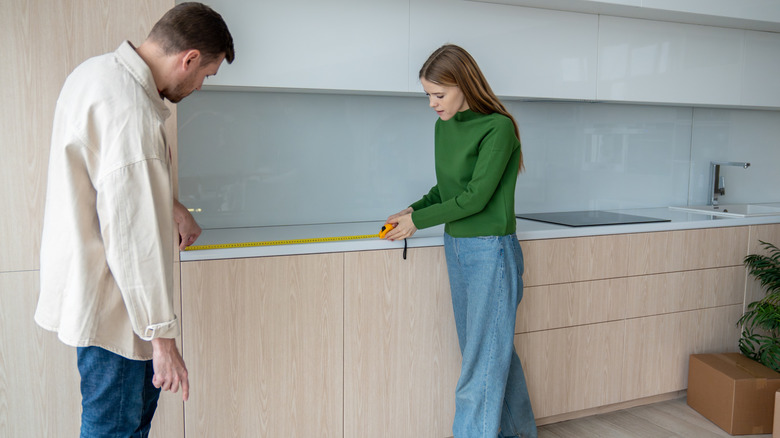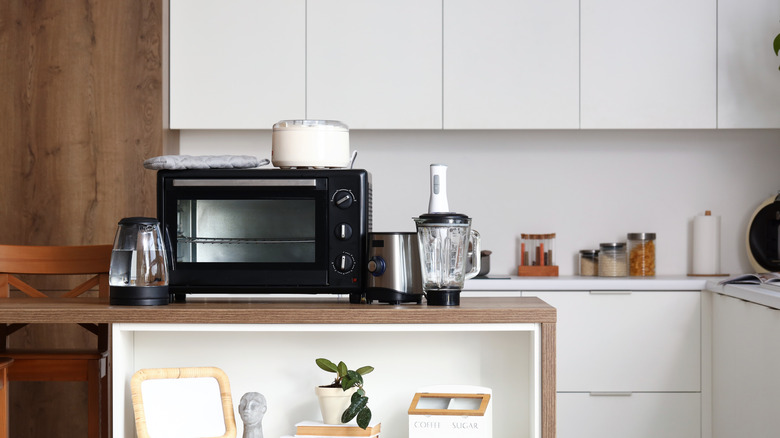Common Mistakes To Avoid Making With A Countertop Oven
Countertop ovens make the perfect quick-heating appliance or even an oven alternative for smaller kitchens. While you may want to get this oven on your counter to start cooking, you may find yourself in a pickle with serious and even potentially dangerous issues. Don't do this to yourself! Instead, learn why improper set-up, bakeware choices, lack of cleaning, and on-top storage are common mistakes to avoid making with a countertop oven.
Before dishing out some avoidable problems, it is important to understand that the first and most common blunder many of us make is assuming that all ovens are the same. But what's the real difference between toaster ovens and countertop ovens? The main distinction between these two appliances is that toaster ovens require less space than countertop ovens. Most toaster ovens heat toast and small leftovers, while countertop ovens can do that and bake sheet pan meals. Toaster ovens usually have one function, but countertop ovens have an increased temperature range and often offer a variety of features, like air frying.
Countertop oven set-up and bakeware choices
While you want to choose the best reliable countertop ovens, the overall setup and the type of bakeware you use make the difference in your overall selection. Before you add this appliance to your counters, you need to make sure you have enough room. Grab a measuring tape and determine how much space you have before purchasing one for your kitchen, taking into consideration the availability of electrical outlets. On average, countertop ovens run about 17 to 22 inches and need about 2 feet of space. While you may be tempted to place this device in any available spot in your kitchen, each oven type needs sufficient room for ventilation. Refer to the appliance manufacturer's guidance, but expect to need about 4 to 6 inches of clear space between each side of the oven between other appliances and walls..
The type of bakeware you use with your countertop oven is vital. Similar to conventional ovens, look for pieces that say oven-safe, including glass and ceramic options. Cookware not graded for ovens can crack and splinter under high heat; instead, opt for steel or aluminum items. Before purchasing any pan, always check bakeware measurements to ensure it fits in your countertop oven. To increase the longevity of your metal sheet and help with clean-up, remember to cover the pan securely with foil or parchment paper. But not all ovens can handle foil — and never use it as a drip catch in the bottom — so check your manual before use and fit it securely on the pan.
Cleaning and storage habits play a vital role
Just like every other appliance in your home, your countertop oven needs proper cleaning and storage habits to last a long time. It's important to remember to get the inside of your oven sparkling clean after every use to avoid overheating from burnt food. However, the inside isn't the only place to worry about cleaning. A common mistake that many people make is skipping cleaning the crumb tray. Your oven's crumb tray needs to be cleaned after every use; otherwise, these crumbs can burn during the device's next use. That said, always check the manual to see which parts are dishwasher safe and which need handwashing.
Storage is another important consideration for a countertop oven, and we're not just talking about storing the appliance itself. A common mistake many people make is storing items on top of or even inside their countertop appliances. While you may be tempted to put trays, decor, or other items on the top surface, beware that this could cause your oven to overheat, leading to a potential fire. Even storing plates or silverware is a no-no since these items could melt or burn. When not in use, unplug your oven and wrap the cord around the appliance.


